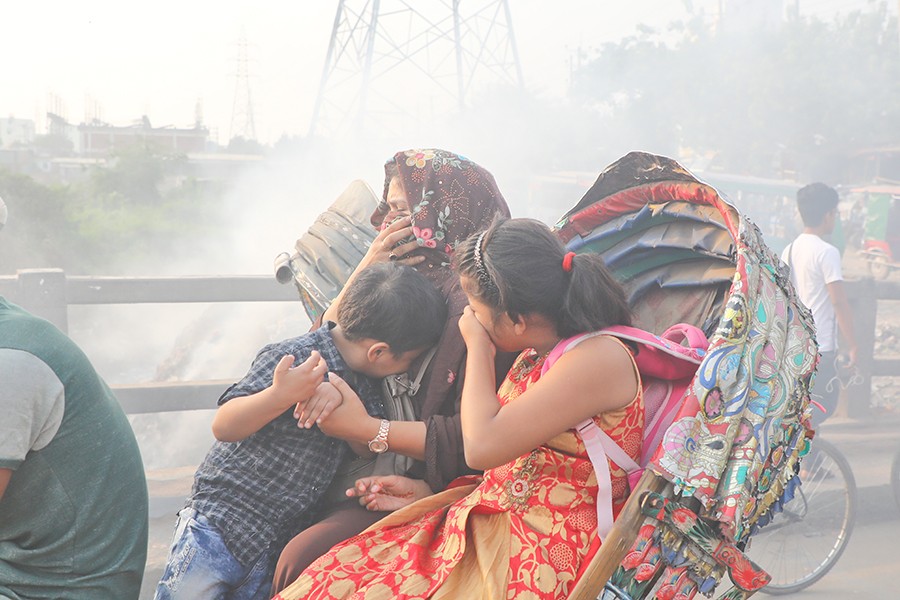Children, the elderly crowd hospitals as Dhaka's air quality keeps worsening

Published :
Updated :

Children and elderly people have been facing nasal, ophthalmological, and respiratory diseases due to air pollution made worse by the construction of flyovers, roads, and the metro rail.
The diseases began to spread with the advent of winter, sending more patients to hospitals.
A huge crowd was seen seeking treatment at the outdoor department of the National Institute of Diseases of the Chest and Hospital in Mohakhali on Wednesday.
Jhinuk, a homemaker from Ibrahimpur, is having respiratory problems more frequently as winter set in.
"I can't endure dust but it is impossible to walk on the street without being exposed to a cloud of dust. My house is filled with dust too. All of it increased my asthma attack and I ended up here seeking treatment," she said.
The NIDCH saw an increased number of patients in October, according to the outpatient department of the hospital. Some of them died, reports bdnews24.
The hospital recorded 4,716 patients who visited the outpatient department seeking medical help for respiratory problems in the first 12 days of November.
Most of them were more than 50 years of age, said the hospital authority. Children are there among the regular patients. The number of child patients went up in October.
There is not enough accommodation to provide treatment to the patients as their number rose, said Dr Md Serajul Islam, resident physician at the Respiratory Medicine Department of NIDCH.
"A small number of patients visit our hospital from other parts of the country during this harvest season," he said.
None of the 665 beds in the hospital is vacant at the moment, Islam said.
More children were seen visiting the Asthma Centre at Dhaka Shishu Hospital. Shah Alam from Mirpur 11 brought his three-year-old son Abdullah suffering from respiratory ailment to the hospital.
"I always use a mask and put one on my son too, when he goes out with us. Even then we couldn't avoid the disease. He has been suffering from cold and respiratory problems over the past three days,” said Alam, blaming it on dust that blanketed his neighbourhood.
Nazmul Hasan from Pirerbag in Mirpur said his son Amiyo becomes more vulnerable to respiratory ailments in winter.
“The entire house gets covered in dust if we keep the windows open for two days,” he said.
There was a decline in the number of patients when the transport strike began on November 18, but more patients began to come with respiratory problems, said Asthma Centre Coordinator Dr Quamruzzam.
More children are coming in for treatment. Data shows 33 children received services from the centre on November 22, compared to 22 a day earlier.
“Air pollution can harm the eyes, nose and the respiratory system. It causes burning of the eyes, watery eyes and different nasal ailments," said Dr ABM Abdullah, dean of Bangabandhu Sheikh Mujib Medical University. It may even cause cancer in children and elderly people, he said.
"Harmful particles in the air attack throats and lungs. Some particles cause cancer too. The children are affected more as they are exposed to it. The immune system of the elderly weakens with age and fall sick easily."
The presence of harmful particulate matter in the air has multiplied beyond the tolerable limit, according to the Department of Environment.
On Tuesday, the particulate matter was 190 ppm (parts per million) in the Dhaka air. It was much more than the tolerable level in an entire week.
Curbing air pollution is the key to preventing the diseases caused by it, said the doctors.
Polluted air or dust has a direct connection to the respiratory tract diseases, said Dr Quamruzzaman Quamrul.
“Bronchiolitis, pneumonia, asthma and tuberculosis in children are linked to dust and pollution. The asthma patients suffer more during winter because of the dust particles that enter the trachea and reach the lungs. We get more patients with respiratory tract diseases at this time.”
Spraying water on dust in the affected areas as directed by the High Court will not alleviate the situation, Serajul Islam said.
“We need to use modern technology to suck out the harmful matters from the air.”
Dhaka City Corporation took some measures to curb air pollution but the major responsibility to prevent air pollution lies with the Department of Environment, said Dhaka South City Corporation Mayor Sayeed Khokon.
“We’re regularly spraying water on roads using the water bowsers to control dust.”
Particle pollution, also called particulate matter (PM), is a mixture of hazardous solid and liquid particles in the air that can lead to serious health issues. The particles vary in sizes, ranging from 2.5 (PM2.5) to 10 (PM10) micrometres in diameter, and its prevalence in an area is used to determine the quality of the air.
Experts say that an Air Quality Index (AQI) rating of 0-50 represents ‘good’ quality of air while 51-100 is considered ‘moderate’ and 101-150 is deemed ‘dangerous’. But the air quality is classified as ‘unhealthy’ when the PM levels reach 150-200, ‘very unhealthy’ at 201-300 and ‘hazardous’ at 301-500.
The Clean Air and Sustainable Environment project measures the ultra-micro PM 2.5 at 11 points within the jurisdiction of the city corporations.
Bangladesh has recently topped the list of 73 countries with air pollution prepared by Airvisual.com in 2018. According to them, there is 97.10 microgram particulate matter of 2.5 micrometres in diameter in every cubic metre of air in Bangladesh.
On Tuesday, the High Court ordered the government to form a panel led by the environment secretary to draft a policy to curb air pollution.


 For all latest news, follow The Financial Express Google News channel.
For all latest news, follow The Financial Express Google News channel.